Abstract
OBJECTIVE: To describe family caregivers' experiences with palliative care services in rural communities. DESIGN: Qualitative study. SETTING: Manitoulin Island, Ont. PARTICIPANTS: Thirteen family caregivers of 12 deceased patients who had received palliative care services. METHOD: Twenty-five family caregivers were recruited by mail and local newspaper. Eight were excluded because they lived off the Island or were too recently bereaved; one declined an interview; and three were excluded by researchers. Initial contact was by telephone; those retained (13 people) were interviewed at home. Interviews were conducted by the same researcher using a semistructured interview guide. All interviews were audiotaped and transcribed, and content was analyzed. MAIN FINDINGS: Three interwoven themes were identified: access to services, quality of services, and support and caring. Hospital and community-based services were accessed with ease at the local level; difficulties were noted when accessing services in tertiary care centres. Participants were generally grateful for and pleased with services received. Two areas of concern raised by participants were communication and pain and symptom control. Participants suggested to the Ministry of Health ways to improve rural palliative care services. More public funding for in-home palliative care services was identified as a priority. CONCLUSION: Participants thought good services and supportive care at the local level made up for difficulties in accessing and using palliative services in tertiary care centres. Community spirit and culture were seen as making situations more bearable.
Full text
PDF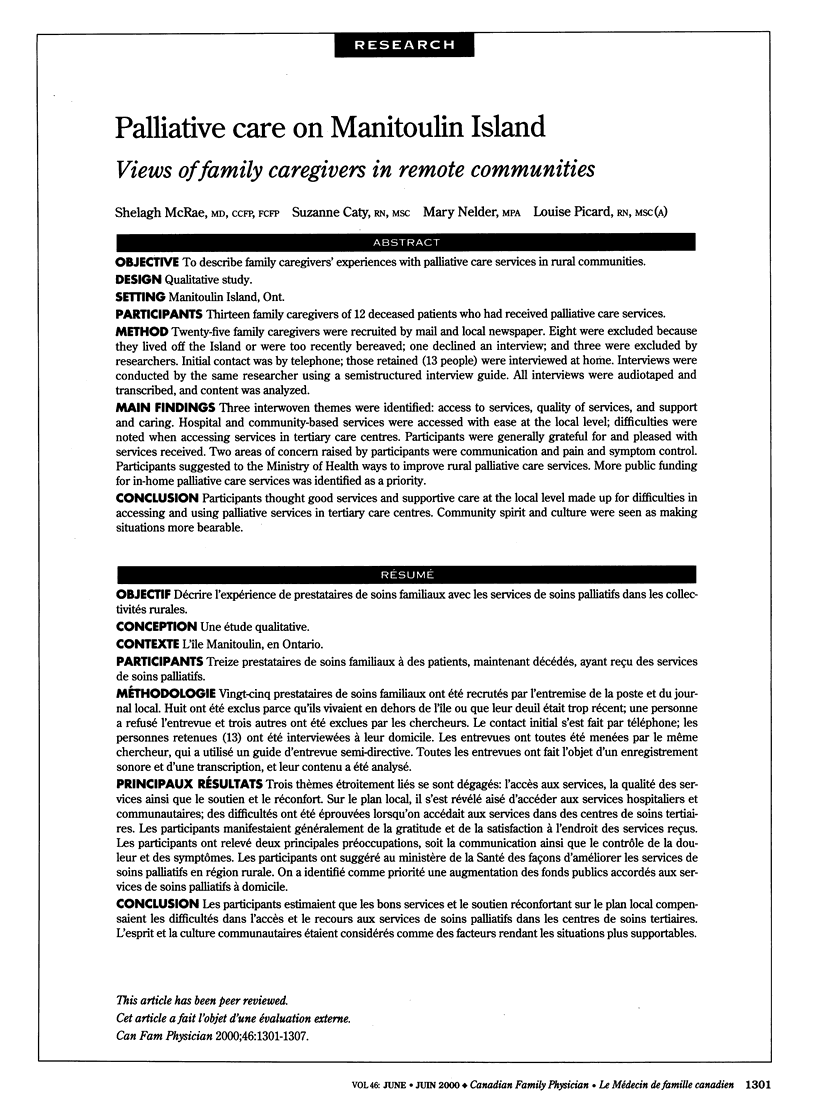
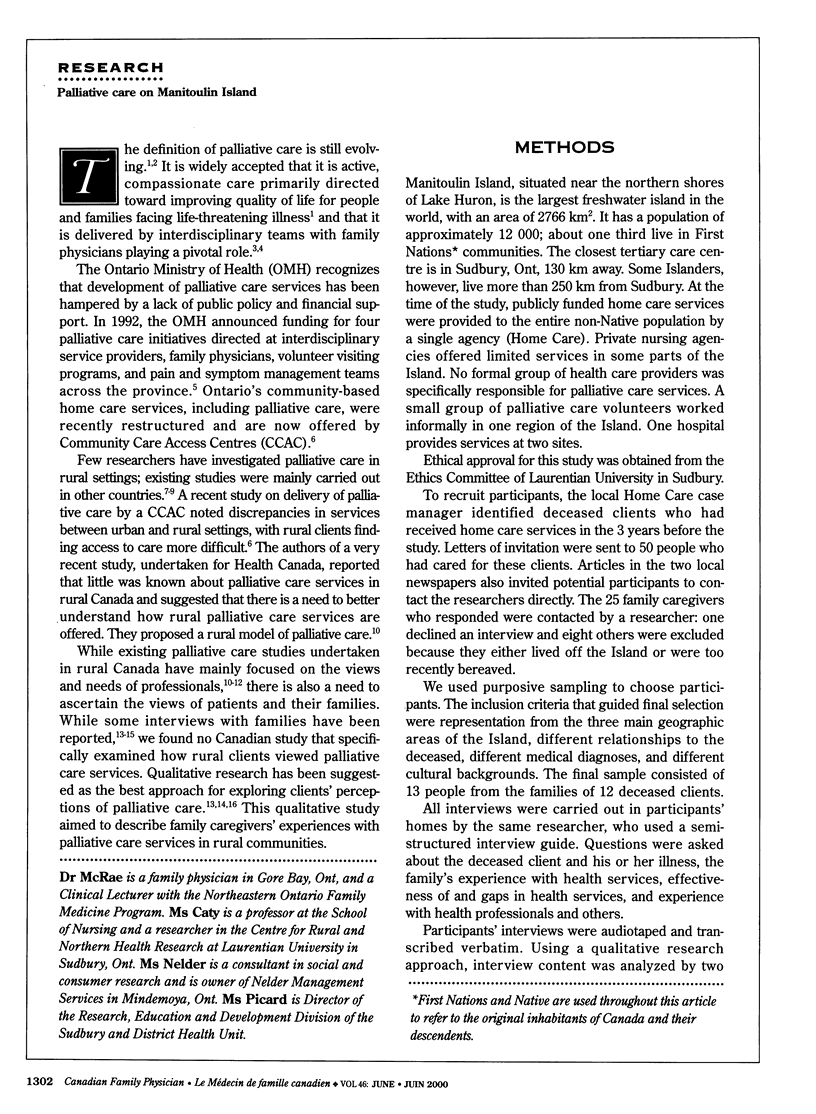
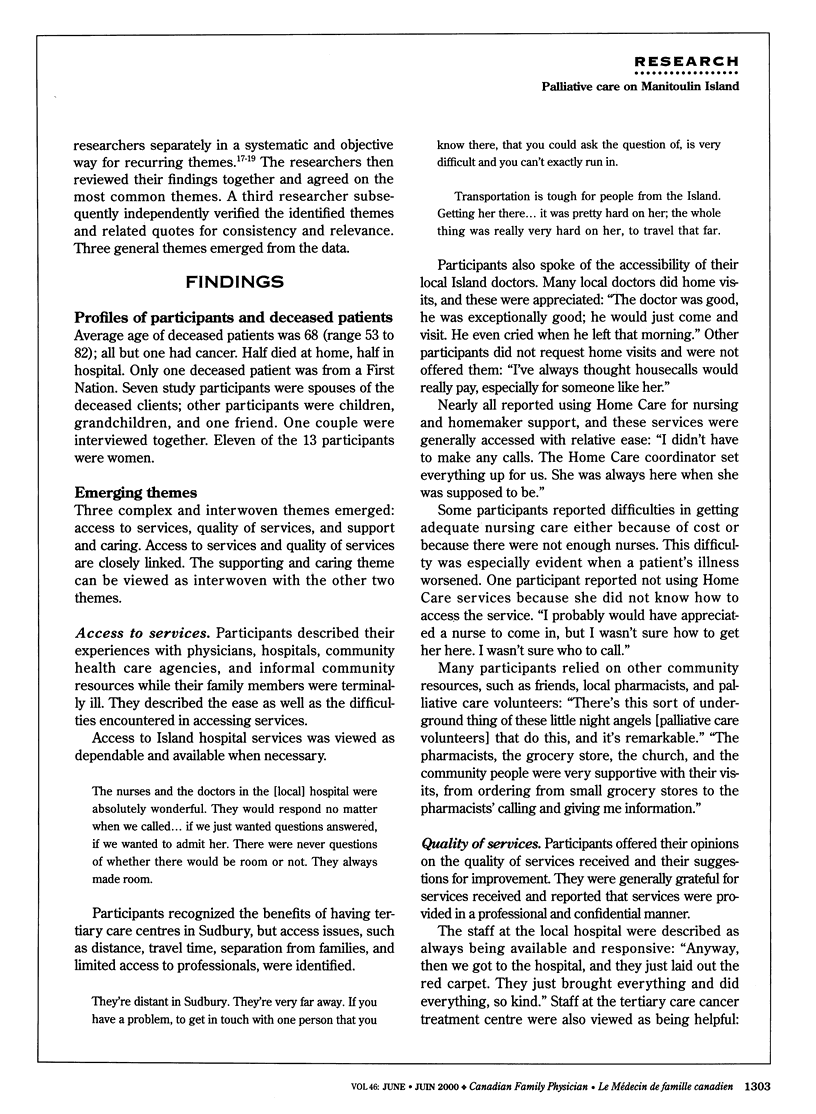
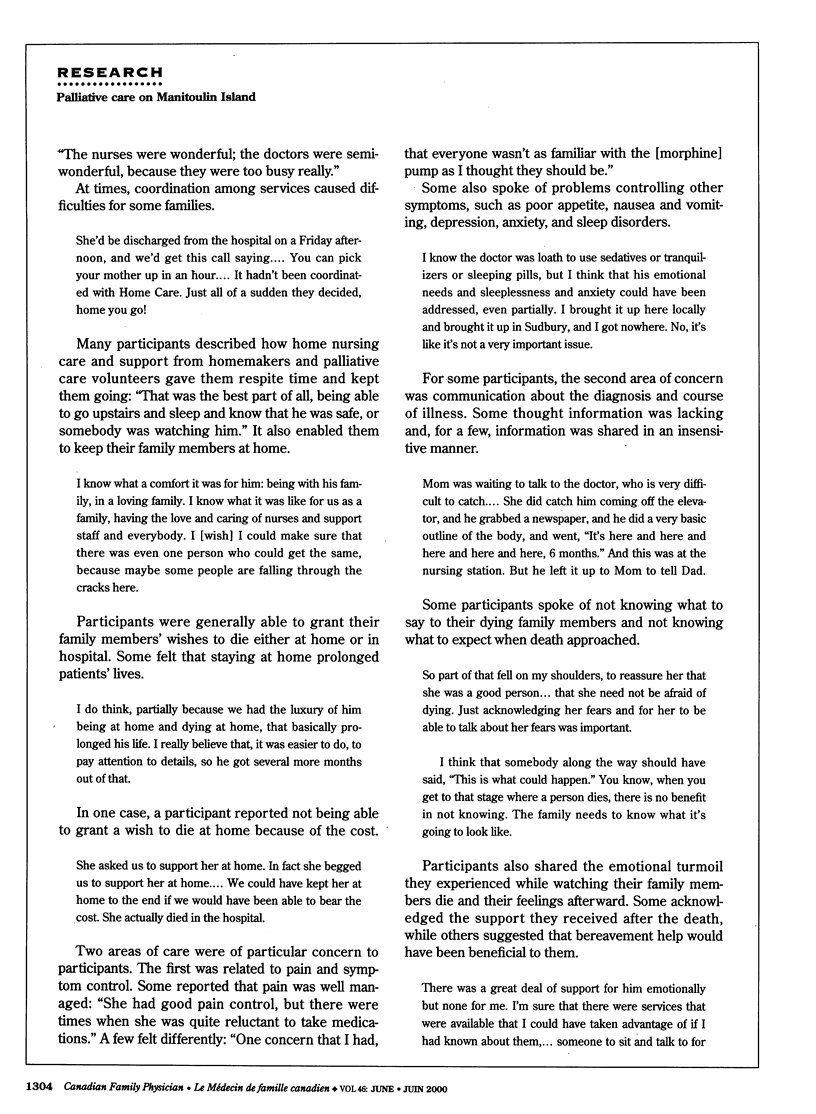

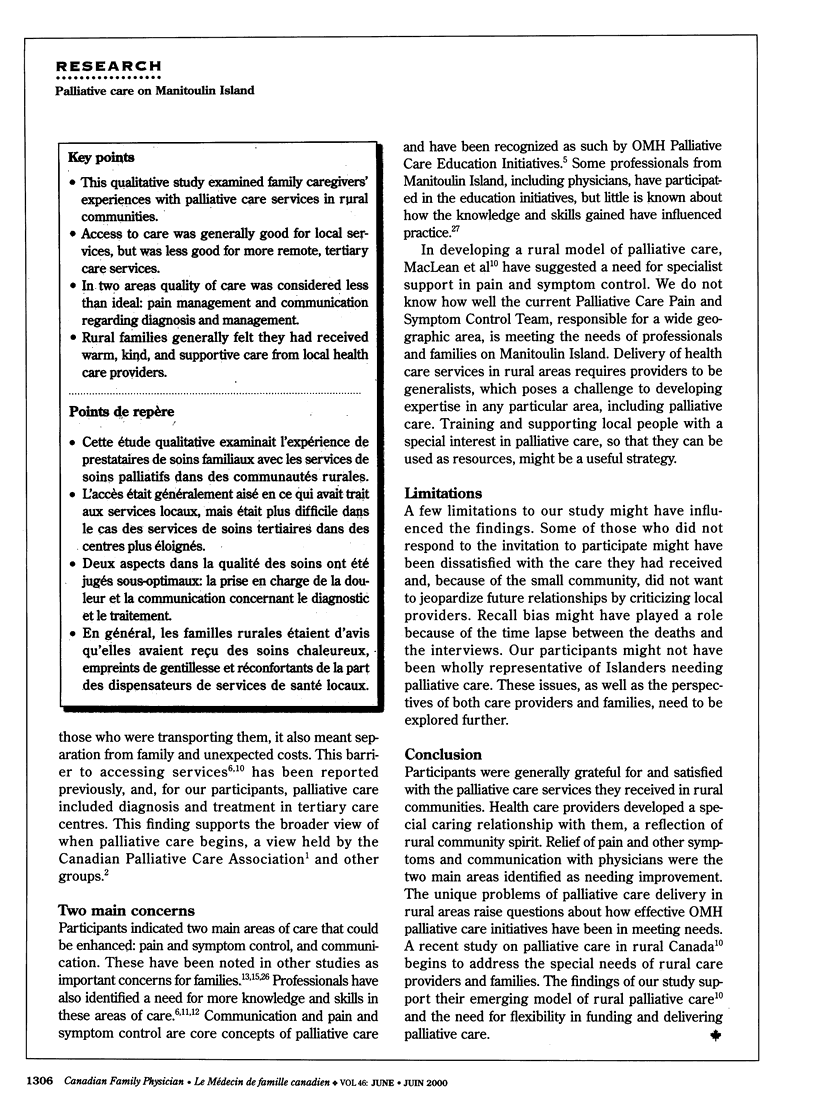
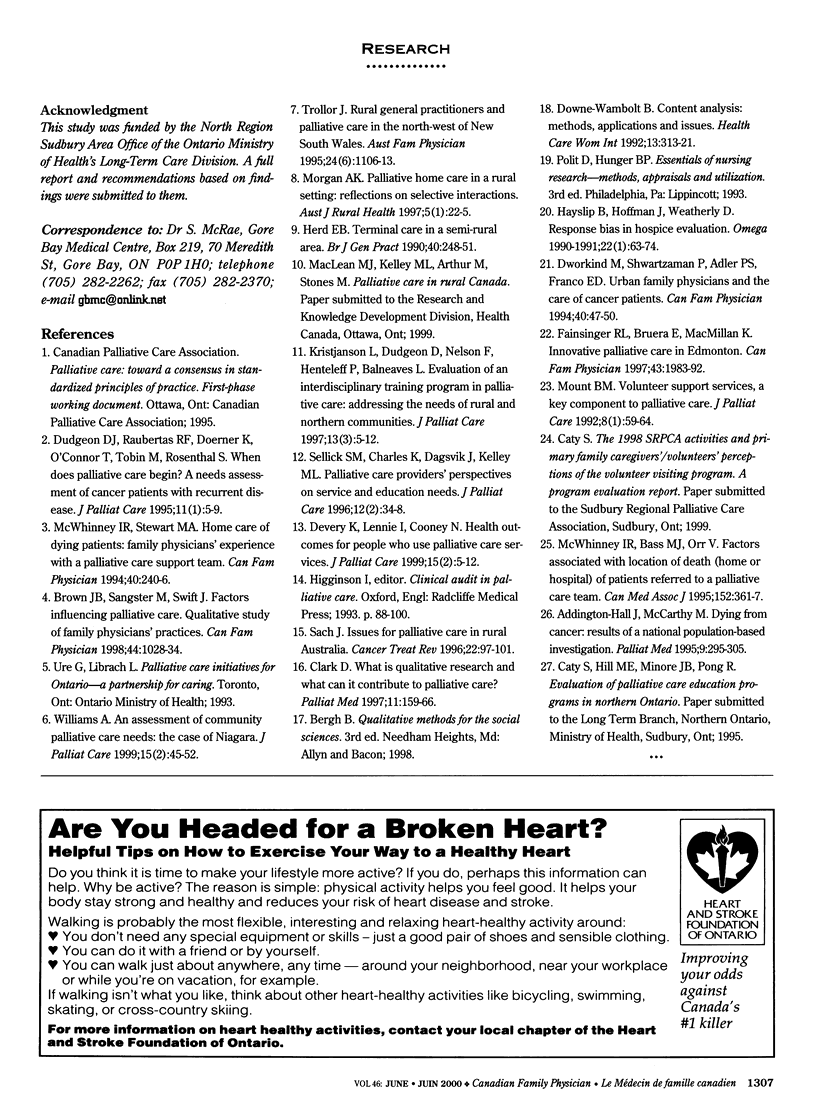
Selected References
These references are in PubMed. This may not be the complete list of references from this article.
- Addington-Hall J., McCarthy M. Dying from cancer: results of a national population-based investigation. Palliat Med. 1995 Oct;9(4):295–305. doi: 10.1177/026921639500900404. [DOI] [PubMed] [Google Scholar]
- Brown J. B., Sangster M., Swift J. Factors influencing palliative care. Qualitative study of family physicians' practices. Can Fam Physician. 1998 May;44:1028–1034. [PMC free article] [PubMed] [Google Scholar]
- Clark D. What is qualitative research and what can it contribute to palliative care? Palliat Med. 1997 Mar;11(2):159–166. doi: 10.1177/026921639701100211. [DOI] [PubMed] [Google Scholar]
- Devery K., Lennie I., Cooney N. Health outcomes for people who use palliative care services. J Palliat Care. 1999 Summer;15(2):5–12. [PubMed] [Google Scholar]
- Downe-Wamboldt B. Content analysis: method, applications, and issues. Health Care Women Int. 1992 Jul-Sep;13(3):313–321. doi: 10.1080/07399339209516006. [DOI] [PubMed] [Google Scholar]
- Dudgeon D. J., Raubertas R. F., Doerner K., O'Connor T., Tobin M., Rosenthal S. N. When does palliative care begin? A needs assessment of cancer patients with recurrent disease. J Palliat Care. 1995 Spring;11(1):5–9. [PubMed] [Google Scholar]
- Dworkind M., Shvartzman P., Adler P. S., Franco E. D. Urban family physicians and the care of cancer patients. Can Fam Physician. 1994 Jan;40:47–50. [PMC free article] [PubMed] [Google Scholar]
- Fainsinger R. L., Bruera E., MacMillan K. Innovative palliative care in Edmonton. Can Fam Physician. 1997 Nov;43:1983-6, 1989-92. [PMC free article] [PubMed] [Google Scholar]
- Herd E. B. Terminal care in a semi-rural area. Br J Gen Pract. 1990 Jun;40(335):248–251. [PMC free article] [PubMed] [Google Scholar]
- Janson L. K., Dudgeon D., Nelson F., Henteleff P., Balneaves L. Evaluation of an interdisciplinary training program in palliative care: addressing the needs of rural and northern communities. J Palliat Care. 1997 Autumn;13(3):5–12. [PubMed] [Google Scholar]
- McWhinney I. R., Bass M. J., Orr V. Factors associated with location of death (home or hospital) of patients referred to a palliative care team. CMAJ. 1995 Feb 1;152(3):361–367. [PMC free article] [PubMed] [Google Scholar]
- McWhinney I. R., Stewart M. A. Home care of dying patients. Family physicians' experience with a palliative care support team. Can Fam Physician. 1994 Feb;40:240–246. [PMC free article] [PubMed] [Google Scholar]
- Morgan A. K. Palliative home care in a rural setting: reflections on selective interactions. Aust J Rural Health. 1997 Feb;5(1):22–25. doi: 10.1111/j.1440-1584.1997.tb00230.x. [DOI] [PubMed] [Google Scholar]
- Mount B. M. Volunteer support services, a key component of palliative care. J Palliat Care. 1992 Spring;8(1):59–64. [PubMed] [Google Scholar]
- Sellick S. M., Charles K., Dagsvik J., Kelley M. L. Palliative care providers' perspectives on service and education needs. J Palliat Care. 1996 Summer;12(2):34–38. [PubMed] [Google Scholar]
- Smith T. J., Desch C. E., Grasso M. A., McCue M. J., Buonaiuto D., Grasso K., Johantgen M. E., Hackney M. H., Shaw J. E., Simonson C. J. The Rural Cancer Outreach Program: clinical and financial analysis of palliative and curative care for an underserved population. Cancer Treat Rev. 1996 Jan;22 (Suppl A):97–101. doi: 10.1016/s0305-7372(96)90069-9. [DOI] [PubMed] [Google Scholar]
- Trollor J. Rural general practitioners and palliative care in the north-west of New South Wales. Aust Fam Physician. 1995 Jun;24(6):1106-9, 1112-3. [PubMed] [Google Scholar]
- Williams A. An assessment of community palliative care needs: the case of Niagara. J Palliat Care. 1999 Summer;15(2):45–52. [PubMed] [Google Scholar]


